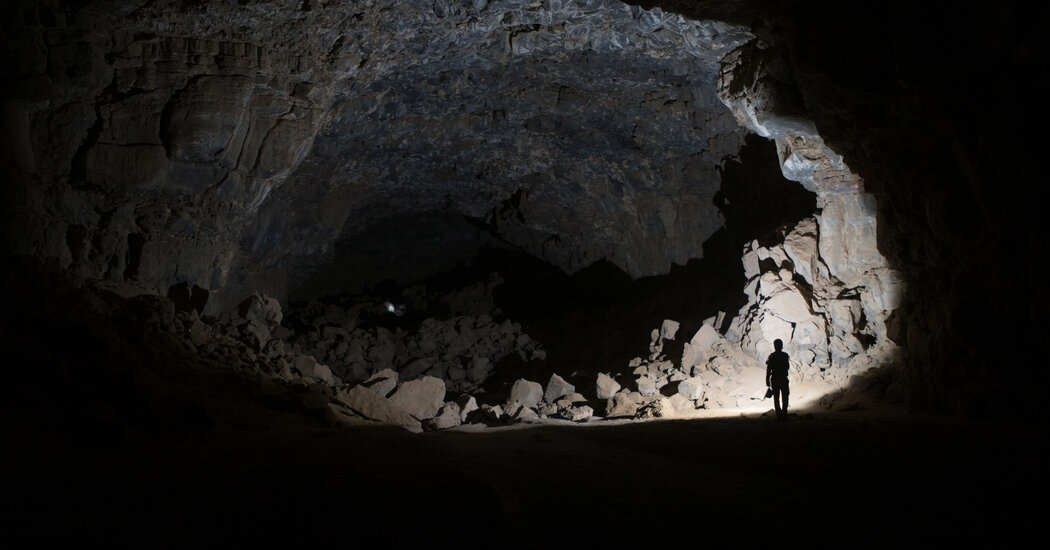

In the rainforests of western Panama, the plant biologist Jim Dalling stumbled upon some tree ferns with six-foot-long leaves that bent to the ground as they were dying, encircling the plant like a skirt.
“I was trying to move these things out of the way and then in the process, I realized these were rooted into the ground,” Dr. Dalling said. A professor and forest ecologist at the University of Illinois, he had been searching for a completely unrelated plant.
The fern’s leaf remnants were brown and withered — dead, by all appearances (though still attached at their base to the tree fern’s trunk). How could lifeless plant matter be endowed with roots? he wondered.
“I couldn’t really believe what I was seeing,” Dr. Dalling said.
Further study revealed that this tree fern, known as Cyathea rojasiana, transforms the inner part of its dead or dying leaves. The remnants of the xylem and phloem — tubules that transport water, sugars and nutrients throughout living leaves — somehow become a root.
The tips of these fronds, nicknamed “zombie leaves,” then sprout new fine roots that penetrate the soil, said Dr. Dalling, co-author of a study describing the findings published in January in the journal Ecology.
In the process of transmuting the mid-rib of the leaf, the plant undergoes a proliferation of new vascular tissue — and avoids rotting while the rest of the leaf withers away.
“This is completely unknown in any other plant in the world,” he said.
“Normally the vascular tissue is laid down in the leaf and that’s it,” said Robbin Moran, a fern expert and curator emeritus at the New York Botanical Garden in the Bronx. But with this species, after the rest of the leaf dies, “it’s differentiating, proliferating. I don’t know how that happens.”
“I have never seen anything like it,” added Dr. Moran, who wasn’t involved in the paper.
This tree fern is found in a soggy area of the Fortuna Forest Reserve, which is drenched by more than 20 feet of rain a year. The rain leaches the sandy, volcanic soil, draining it of nitrogen and phosphorus. The researchers believe the fern’s adaptation allows it to tap pockets of nutrients in the topsoil nearby that it otherwise couldn’t access.
Many plants are known for their nearly limitless ability to adapt, and other species can produce new roots from living leaves. Notable examples include the walking fern (Asplenium rhizophyllum), native to the United States, which spreads about mossy rocks using this technique.
But this tree fern’s “zombie leaves,” or leaf roots, represent the first known example of a repurposing of dying tissue, said Eddie Watkins, a professor and fern expert at Colgate University who was not part of the study.
By turning existing leaf material into roots, the plant most likely saves energy, Dr. Watkins suggested. That could help it in the “battle for nutrients” in its part of the rainforest.
Heavy rain and poor soils provide a unique assemblage of plants, including a conifer known as Podocarpus, Greek for “footed fruit” (a reference to the stalked appearance of another species in the genus). This evergreen sends odd bulbous roots everywhere, including up the trunks of surrounding trees. The conifer was the one that led Dr. Dalling to rummage through the brush in the first place.
“It’s just pure chance that we were digging around at the base of these tree ferns,” he said.
Dr. Dalling inspected dozens of these ferns, discovering that each grew roots from its “zombie leaves.” But his work was interrupted by the onset of the coronavirus pandemic, forcing him to leave Panama with his wife and dog and return to Illinois in February 2020.
Two years later, he returned. With colleagues, Dr. Dalling dug up roots from the leaves of three individual plants, placed them in pots and added a fertilizer with chemically labeled nitrogen. A month later, they examined new fronds at the top of the fern and found that the nitrogen was indeed being incorporated into the plant — confirming that these roots were actively transporting water and nutrients.
Much remains unknown, including basically all the developmental and biochemical secrets of how this particular tree fern pulls off such a transformational feat. The discovery speaks to the importance of taking time to study and appreciate the natural world, Dr. Watkins said, adding that this type of exploration has become less frequent and difficult to fund.
“If you stop and look at the organism, there’s some really new and cool stuff out there,” Dr. Watkins said. “There are stories to be told that we haven’t discovered.”
24World Media does not take any responsibility of the information you see on this page. The content this page contains is from independent third-party content provider. If you have any concerns regarding the content, please free to write us here: contact@24worldmedia.com

Common Mistakes When Using Athletic Field Tarps

High-Performance Diesel Truck Upgrades You Should Consider

Warehouse Optimization Tips To Improve Performance

Fire Hazards in Daily Life: The Most Common Ignition Sources

Yellowstone’s Wolves: A Debate Over Their Role in the Park’s Ecosystem

Earth Day 2024: A Look at 3 Places Adapting Quickly to Fight Climate Change

Millions of Girls in Africa Will Miss HPV Shots After Merck Production Problem

This Lava Tube in Saudi Arabia Has Been a Human Refuge for 7,000 Years

Four Wild Ways to Save the Koala (That Just Might Work)

National Academy Asks Court to Strip Sackler Name From Endowment

Ways Industrial Copper Helps Energy Production

The Ins and Out of Industrial Conveyor Belts